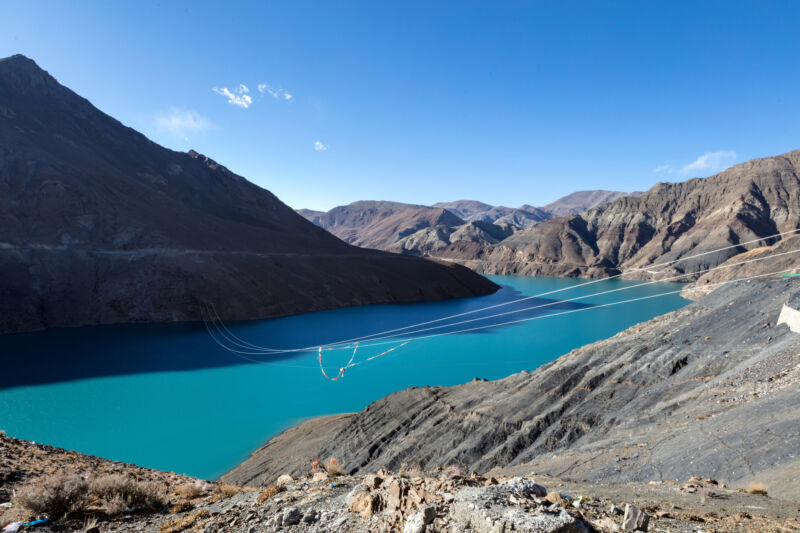A study recently published by a team of researchers at Beijing’s Tsinghua University has revealed plans to construct a 594-foot-tall dam using robots, 3D printing, and artificial intelligence. The researchers claim that no human labor needs to be directly employed in building this massive structure—if the plan moves forward, the dam would produce 5 billion kWh of electricity annually. This much energy will be enough to meet the power demands of 50 million homes in China.
The Yangqu dam is on the second largest river in China, the Yellow River, where it flows through Qinghai Province on the Tibetan plateau. There is already a dam on the river, so the proposal involves enlarging the existing structure and increasing its power generation capacity, making it one of the world’s largest dams. If everything goes as planned, the Yangqua dam will become the biggest ever AI-made 3D-printed structure on the planet.
3D printing without a printer
Construction-scale 3D-printing technology involves the use of giant 3D printers to produce concrete layers that form the structure. In contrast, the researchers at Tsinghua University have developed a method that allows them to 3D-print concrete without a printer. They plan on using an additive manufacturing approach that employs a computerized scheduling system that takes the 3D structure into account. It will use AI-controlled robots instead of a large 3D printer to construct the upgrade to the Yangqu dam.
According to the study, the scheduling system uses the design model of the dam to determine the amount of material required to construct a particular section of the dam. The construction robots assigned to that section then collect the filling material and unload it at the targeted spot. Finally, they perform “intelligent paving and rolling” to turn the material into a 3D-printed layer. Repeating this process creates multiple layers that eventually complete the section.
Explaining the process in detail, the lead author of the study and faculty at Tsinghua University’s School of Civil Engineering, LIU Tianyun, wrote, “Once each construction layer is finished, the robots send construction state information to the scheduling system. The complete filling process is then printed step by step under the control of the 3D printing scheduling system.” During construction, each robot works as labor and as input to the scheduling system; collectively, the robots function as a large 3D printer.
This unique approach could save both time and resources, enabling the construction of multiple sections of the Yangqu dam at once and without a bulky 3D printer that may require continuous human assistance. The robot-made Yangqu dam is set to be operational by 2024—less than two years from now. You can contrast that with two of the other largest man-made dams, the Oroville dam in the US and the Three Gorges dam in China, which took seven and nine years to complete, respectively.
Great idea—will it happen?
The Yangqu dam is not the first impressive additive manufacturing idea proposed by the researchers of Tsinghua University. In 2021, another team of scientists led the development of a 3D-printed retractable bridge in Shanghai. This nine-meter-long bridge is controlled via Bluetooth and can fully expand in less than 60 seconds. The team has also 3D-printed a library building and an 86-foot-long concrete bridge in the past. Given these past successes, there’s a chance that the government will move forward with this group’s latest idea.
However, when 3D printing is combined with AI and robots (as is planned for the Yangqu dam project), it can also pose problems. Constructing a massive structure similar to the Yangqu dam generally demands hundreds of human laborers and many other types of low-skilled workers; widespread adoption of AI-powered robots could put an end to these jobs.
Skilled workers account for roughly 30 percent of China’s total workforce, so automation practices could threaten the livelihood of a large population in the country. Safety is also incredibly important for dams of this size, and we don’t have experience evaluating the output of this sort of process.
3D printing has various advantages over traditional construction methods; for instance, a small house that may take months to complete can be built within 24 hours and at a much lower budget using 3D printing. NASA even has plans to employ 3D printing for building human-friendly structures on the Moon. The approach proposed in this paper has the potential to provide further options for future construction by getting rid of the printer entirely.
Journal of Tsinghua University, 2022. DOI: 10.16511/j.cnki.qhdxxb.2022.25.045 (About DOIs)
Rupendra Brahambhatt is an experienced journalist and filmmaker. He covers science and culture news, and for the last five years, he has worked with news agencies, magazines, and media brands operating in different parts of the globe.



3175x175(CURRENT).thumb.jpg.b05acc060982b36f5891ba728e6d953c.jpg)

Recommended Comments
There are no comments to display.
Join the conversation
You can post now and register later. If you have an account, sign in now to post with your account.
Note: Your post will require moderator approval before it will be visible.